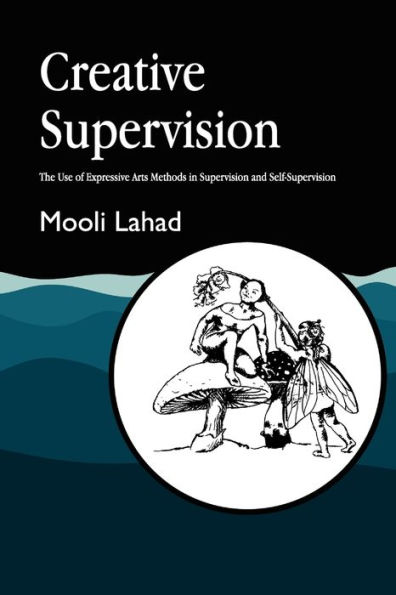Creative Supervision: The Use of Expressive Arts Methods in Supervision and Self-Supervision
Supervision is growing in importance in all professions as a means of focusing on the personal and vocational skills of the supervisee, as well as a means of supporting them in their work. In this book Mooli Lahad argues that the most effective method of supervision uses both right and left hemispheres of the brain, the intuitive and logical. He encourages the use of metaphors, images and stories to enrich theoretical knowledge and improve our understanding of the processes of therapy and support.
In Creative Supervision Lahad introduces techniques, drawn from the expressive arts therapies, which can be employed during a supervision to release information from the creative hemisphere of the brain. These techniques include storytelling, role-playing, guided fantasy, imaginary dialogues, letter-writing, drawing, and the use of colours and shapes. Case examples show how the techniques were used, and how they provided insight into problematic relationships with clients. Drawing from his experiences of working in the aftermath of tragedy in Israel, Northern Ireland and the former Yugoslavia, Lahad examines how to supervise a crisis intervention team: he also focuses on self-supervision.
Combining humanistic, creative and practical approaches, Creative Supervision gives a fresh, new perspective which will inspire supervisors to re-think their practice.
1139980973
In Creative Supervision Lahad introduces techniques, drawn from the expressive arts therapies, which can be employed during a supervision to release information from the creative hemisphere of the brain. These techniques include storytelling, role-playing, guided fantasy, imaginary dialogues, letter-writing, drawing, and the use of colours and shapes. Case examples show how the techniques were used, and how they provided insight into problematic relationships with clients. Drawing from his experiences of working in the aftermath of tragedy in Israel, Northern Ireland and the former Yugoslavia, Lahad examines how to supervise a crisis intervention team: he also focuses on self-supervision.
Combining humanistic, creative and practical approaches, Creative Supervision gives a fresh, new perspective which will inspire supervisors to re-think their practice.
Creative Supervision: The Use of Expressive Arts Methods in Supervision and Self-Supervision
Supervision is growing in importance in all professions as a means of focusing on the personal and vocational skills of the supervisee, as well as a means of supporting them in their work. In this book Mooli Lahad argues that the most effective method of supervision uses both right and left hemispheres of the brain, the intuitive and logical. He encourages the use of metaphors, images and stories to enrich theoretical knowledge and improve our understanding of the processes of therapy and support.
In Creative Supervision Lahad introduces techniques, drawn from the expressive arts therapies, which can be employed during a supervision to release information from the creative hemisphere of the brain. These techniques include storytelling, role-playing, guided fantasy, imaginary dialogues, letter-writing, drawing, and the use of colours and shapes. Case examples show how the techniques were used, and how they provided insight into problematic relationships with clients. Drawing from his experiences of working in the aftermath of tragedy in Israel, Northern Ireland and the former Yugoslavia, Lahad examines how to supervise a crisis intervention team: he also focuses on self-supervision.
Combining humanistic, creative and practical approaches, Creative Supervision gives a fresh, new perspective which will inspire supervisors to re-think their practice.
In Creative Supervision Lahad introduces techniques, drawn from the expressive arts therapies, which can be employed during a supervision to release information from the creative hemisphere of the brain. These techniques include storytelling, role-playing, guided fantasy, imaginary dialogues, letter-writing, drawing, and the use of colours and shapes. Case examples show how the techniques were used, and how they provided insight into problematic relationships with clients. Drawing from his experiences of working in the aftermath of tragedy in Israel, Northern Ireland and the former Yugoslavia, Lahad examines how to supervise a crisis intervention team: he also focuses on self-supervision.
Combining humanistic, creative and practical approaches, Creative Supervision gives a fresh, new perspective which will inspire supervisors to re-think their practice.
35.95
In Stock
5
1

Creative Supervision: The Use of Expressive Arts Methods in Supervision and Self-Supervision
128
Creative Supervision: The Use of Expressive Arts Methods in Supervision and Self-Supervision
128Paperback(New Edition)
$35.95
35.95
In Stock

Product Details
| ISBN-13: | 9781853028281 |
|---|---|
| Publisher: | Jessica Kingsley Publishers |
| Publication date: | 08/01/2000 |
| Series: | Arts Therapies |
| Edition description: | New Edition |
| Pages: | 128 |
| Product dimensions: | 6.18(w) x 9.13(h) x 0.31(d) |
About the Author
From the B&N Reads Blog
